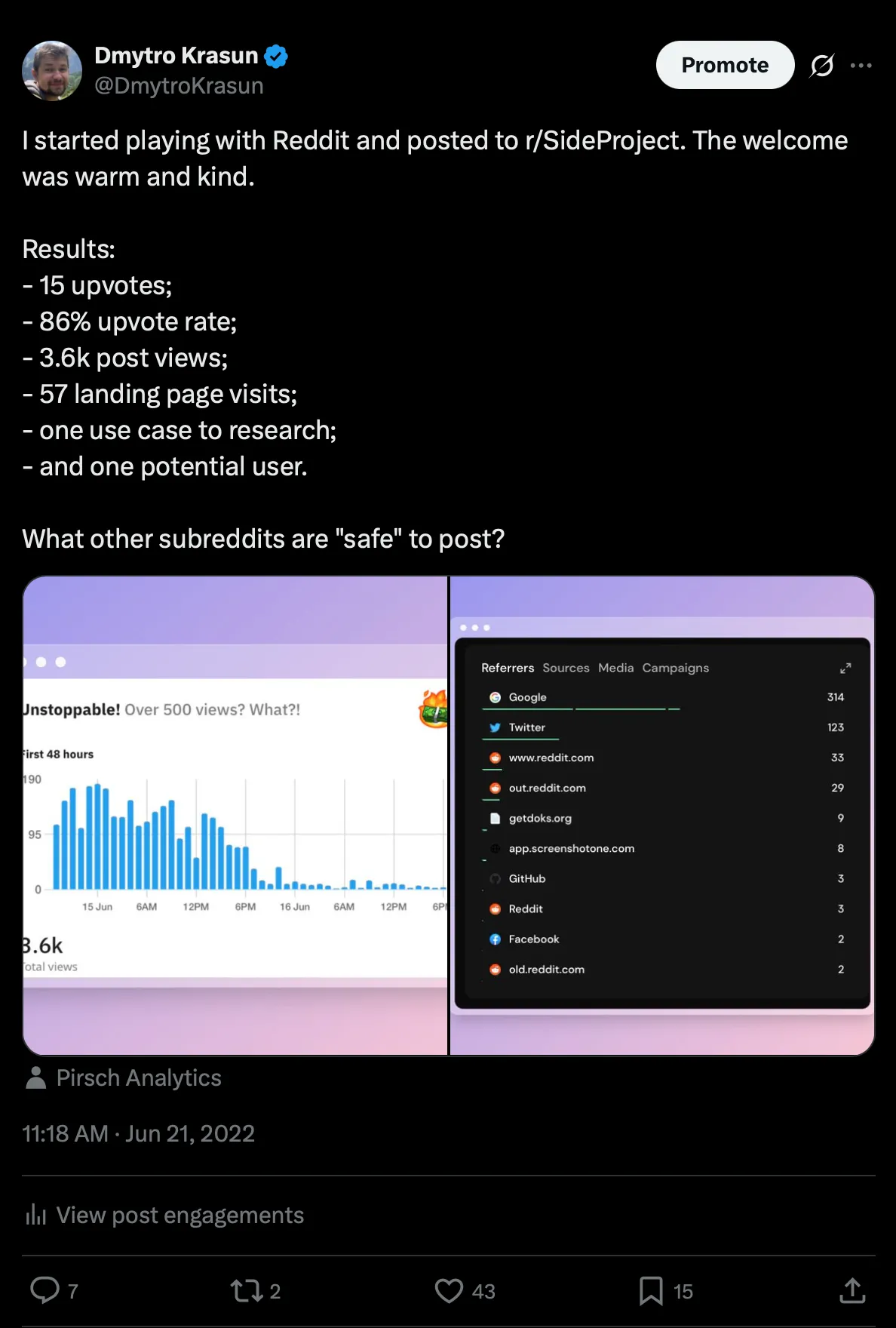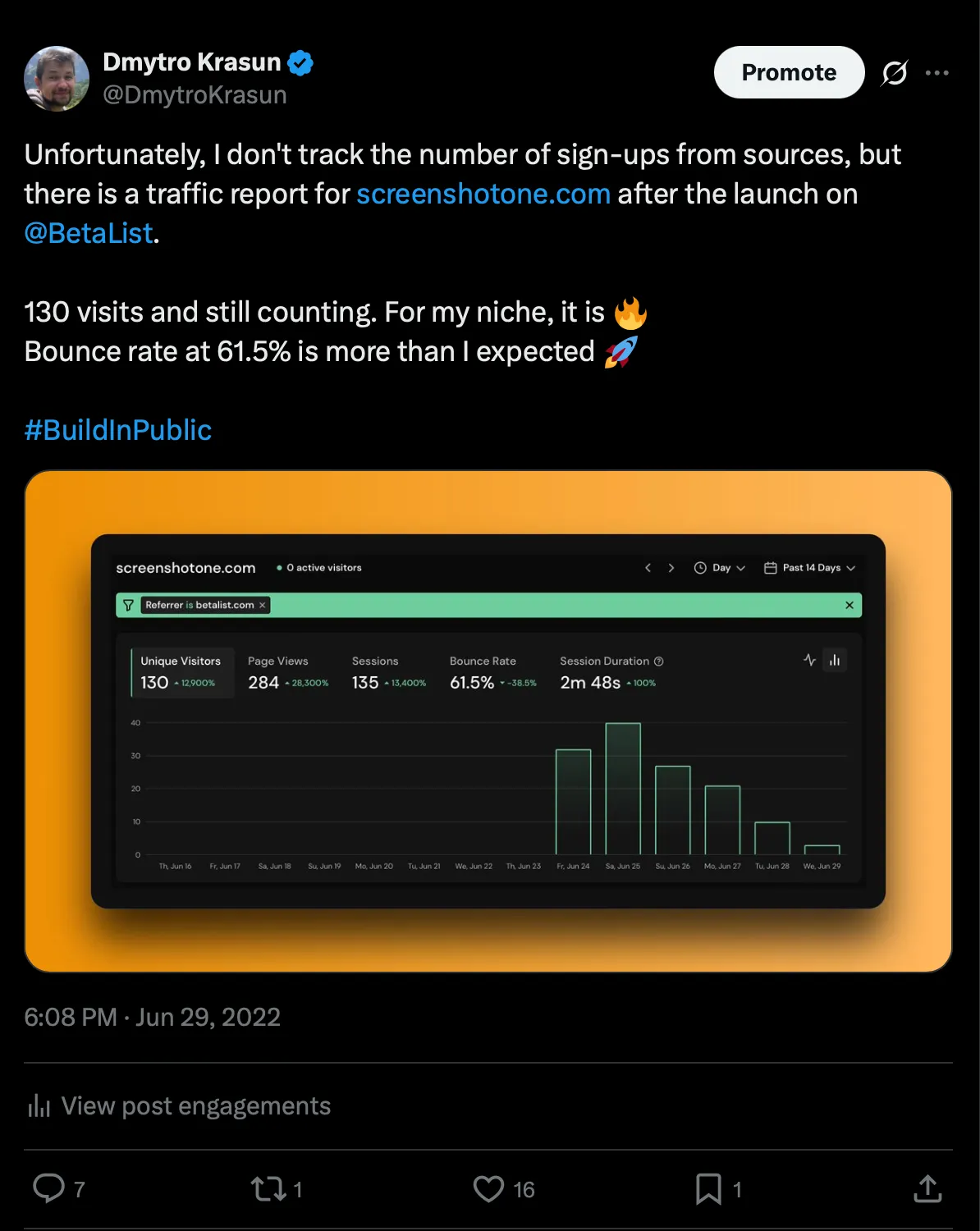Lessons Learned from the First Marketing Month
It won’t be an overnight success. Now I know it for sure.
At the end of May, I launched my screenshot API, the second project in my 1001 project journey. And right away, I defined the next simple goal to attract the first paying customers by the end of July.
I love the project and will continue to grow it anyway, but if I can’t find paying customers by the end of July. I will decrease the amount of time I invest in it, and will try a lot of new ideas. Some of the ideas might use the project.
I have not reached my goals, but I have one more month. In this note, I want to reflect on what went well and what went wrong, and my plans.
What have I tried?
- Paid Google Ads.
- Reddit.
- SEO.
- BetaList and other directories.
- Direct outreach on Twitter.
- Indirect marketing on Twitter.
Before I share in detail my lessons and my plans, these are key metrics:

I don’t automate it now. Entering the data manually helps me reflect on it (the author of idea — Fed (GummySearch)).
By the way, my analytics is open. Feel free to play with it.
Experiments I tried
Paid Google search ads
I started with paid ads to get at least some traffic and see how users will use my product if they sign up or not.
And it helped. I fixed a ton of bugs, improved performance, added new features, and added the “Sign In with Google” feature:
And I made a lot of mistakes. I paid $515 for 2144 clicks, so the cost-per-click is $0.25. 0 paying customers.
Lessons learned:
- It is better to have a polished (tested) product with good positioning if you are low on budget. Your goal is to maximize the conversion rate (sign-ups/visits).
- Use negative keywords. If I sell screenshot API, I don’t want to get visitors that search for screenshots on desktop. If you don’t do it, you can burn your budget quickly.
- Use exact match for the keywords. If you don’t match keywords exactly, you might be surprised how fast and for what keywords you can burn your budget.
- Specify the exact countries for which you want to promote. Start from a small set.
- You can also specify hours when the ad is running. I set my working hours in case something happens, or a potential customer asks questions.
- I should experiment more with ad text and landing pages for different use cases. For example, I can add a landing page for the “take screenshots in JavaScript” search query and promote related keywords in the ad.
I was afraid to post on Reddit because it has this aura of community that bans mercilessly anyone who tries to promote anything, even by helping others. So, I decided to start from the most promotion-friendly subreddit — r/SideProject.
I looked at the posts, what people share, and how they introduce themselves. I quickly wrote a post about my screenshot API. The results beat my expectations:
A lot of positive feedback, upvotes, and comments. I will continue trying with other communities that folks mentioned under the tweet. I feel that Reddit has good potential.
I also set up f5bot.com to monitor keywords related to my project on Reddit and other forums. In case I can jump into the conversion and help.
I already had an example when a related keyword matched — a question was asked. I jumped and tried to help, but unfortunately, I did not receive any response.
Lessons learned:
- I introduced the project and did not just drop a link.
- I replied with every response.
- I could promote a Reddit post on Twitter among my friends.
- I could emphasize my journey rather than the project itself.
- I should try to help as much as possible, even without a link. I can say that I have a product.
SEO
I started to write content long before I launched the project.
I wrote a long post on how to take screenshots with Puppeteer. And started gathering traffic. Once I saw the keywords for which the project ranked, I improved the original post and added more posts. I help people by trying to satisfy their search requests.

As you see, the visits are growing. And for some of the keywords, I reached the first page:
Lessons Learned:
- Start as early as possible from SEO.
- Write one large post related to your niche or your product. Start observing traffic and keywords and then optimize.
- Once SEO kicks off, it is impossible to stop. In the past week, I did not have a day without organic visits from Google.
- I should have worked on the backlinks on day one.
- I should have started to optimize for critical keywords by day one.
BetaList and other directories
I was afraid to launch because they had rigorous requirements for the landing and the product idea. But then I thought, why not? It can be a kind of validation.
When I launched, the results were promising for me:
I also gradually added the project to other directories, like alternativeto.net and sideprojectors.com. The results are not that good, but I am happy even for 2 or 3 unique visits per day.
Lessons learned:
- Don’t underestimate the power of launching on different directories. People can still find you through them. They do bring traffic.
- I need to perfect my landing page and launch on ProductHunt. Awareness also helps.
Direct outreach on Twitter
I reached out to 4 people who I knew could benefit from my project. The owners of screenshot image editors. Instead of copying a screenshot of the site, I proposed to allow to enter the URL.
They answered, yes, it is an excellent idea to integrate, but nothing then happened. I’m not upset. It is fine. The earlier I know there is no value, the fast I can move further and iterate.
One person said that this feature is on their roadmap. If they decide to integrate, I will be happy. If not, it is OK.
Lessons learned:
- I should talk to more people, and it is not enough.
- People are nice but still might reject you — nothing wrong with it. Don’t take it personally.
Indirect marketing on Twitter
On Twitter, I #BuildInPublic and tell everything that happens in my journey.
I did not expect to find any users for my current project there, which is too dull and too niche. But there were visitors from Twitter:

And boom! I was super surprised that it might work:
Lessons Learned:
- #BuildInPublic still might work as a marketing strategy.
- Don’t sell to people, but share the lessons learned.
- People might choose your product instead of competitors because of you.
- I read @MeetKevon book “Find Joy in Chaos”, which has a lot of good advice on how to connect with people on Twitter.
Lessons Learned
These are the most important lessons I learned:
- The energy to build and promote a small, simple project like my API might be equal to doing the same job but for a more ambitious project. So, choose the market and the niche wisely.
- Talking to customers is inevitable, and the earlier I can do it, the faster I can build something that satisfies the actual need, not the one I imagine.
- Paid ads are suitable if the budget is small. It is better to run when the product has developed positioning and has a landing page with a reasonable conversion rate.
- SEO is a long-term game. I should work on it from day one. But once it kicks off, it is a massive bonus for any project.
- I should try direct outreach on Twitter, Reddit, and emails.
Next Moves
It is not an exact plan, and it is more of a strategy or canvas:
- My landing page is terrible. I need to improve it dramatically. Thanks to the community, I gathered a lot of feedback. And will refactor it.
- I need to speak with current users and understand their needs better. Make sure they are satisfied.
- I need to get testimonials and show them on the landing page to gain credibility for potential customers.
- I want to run side projects to promote the main project. But side projects that really can help people to solve their problems.
- I will double down on SEO because I love the returns. I need to write more content and share it to get the backlinks.
- I will continue submitting the project to more directories.
- Try cold outreach. Gather a list of potential customers and start sending them direct messages and emails.
Afterwords
As an experienced software engineer (10+ years in back-end development), I picked up a random boring idea that I could build and promote with minimum learning. I did not want it to be fancy and likable, especially with complex UI. And I learned a lot. Now, I can advance and build more complex projects.
I must admit that after all this marketing experience from the first month, I see that promoting some projects might be much easier. But anyway, I can’t imagine what I can build and sell if I succeed with a monotonous screenshot API (for me, it is not boring).
I shared everything and opened all my analytics. I want to share my journey and show that it is not easy but possible. It won’t be an overnight success, but I will surely succeed one day.
And, of course, I share everything in exchange for feedback. If I am doing something wrong, please, tell me. I am super open to critics.
I am most active on Twitter. Feel free to follow me.







